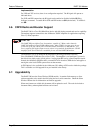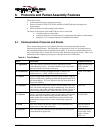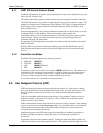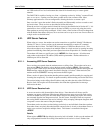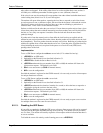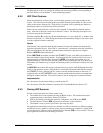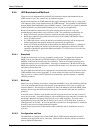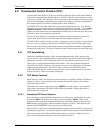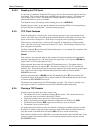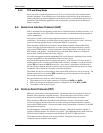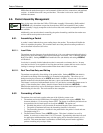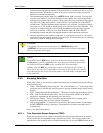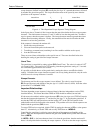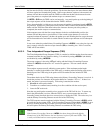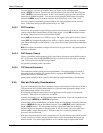
Feature Reference DART 300 Modem
Page 44 2110212 Rev 1.0
6.3.2.2. Disabling the TCP Server
It is possible to completely disable the TCP server so that no client connection requests will ever
be accepted. This prevents the RI signal and RING message from occurring. The modem will
only be able to act as a client. The modem will actually respond to client requests with an
indication that there is no server available.
To disable the server side entirely, set the listening port to zero: +WS212=0.
Disabling the server does not prevent the modem from answering a PING or from responding to
the Sierra Wireless GroupWatcher
™
remote monitoring program.
6.3.3. TCP Client Features
When the modem dials a client session, it will randomly generate a source port number for the
session. The called server will pick up the port number from the packet header in order to route
replies to the correct client process. Each session is assigned a new originating port number.
Client sessions can be dialed by a local host AT command, or automatically when the modem
starts. Auto-dial on Start-up is discussed in Section 5.3 above. The following description is for
hosts using the dial command.
The Dial command (D) can dial any IP and destination port, or it can “quick dial” a member of the
Friends List (Section 5.1 above).
Details
If the modem is not registered when the dial command is issued, the modem will automatically
begin the registration process. The time allowed for registration is set in register +WS198 and
ranges from 1 to 255 seconds (default is 30s).
When registered, the modem will initiate the TCP handshake process. The modem allows a
limited time for the server to respond (S7). This time can range from 15 to 255 seconds (the
default is 30s). The modem will retry the connection request at ten second intervals for up to three
tries. If the server fails to reply within the time allowed, the modem will return the NO
ANSWER result code.
Both the registration timer (+WS198) and the TCP handshake timer (S7) start when the dial
command is issued. If the modem fails to register within the TCP handshake timeout, the modem
will return the NO CARRIER result code.
The modem must register before the TCP handshake can begin. The modem is normally set to
auto-register so that it is available to issue the TCP handshake without undue delay.
6.3.4. Closing a TCP Session
Sessions remain open until one of these events occur:
• The modem receives the command to hang-up (H) the session. This assumes the host has
escaped data state as described in Section 6.6.3 below.
• The remote terminal closes the session (TCP closing handshake).
• DTR is de-asserted, presuming the modem is configured to use DTR for this (&D2).
• The PAD Session Timeout (S30) expires due to inactivity on the connection.
• The modem is reset or power-cycled
For applications where distinct sessions are desirable (connections to differing remotes) and the
host device is unable to issue the escape sequence or toggle DTR, either the remote station can
close the session or the PAD Session Timeout (S30) can close session automatically.
If the local host initiates the close (H, DTR, or reset) then the modem returns the OK result. If the
session is closed by the remote terminal or session timeout, then the modem responds with the
NO CARRIER result.



